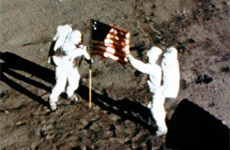NASA
-
NASA sidesteps flaws in FISMA, Microsoft to give feds early warning on security
May 20, 2010 -
Students from across the country worked to develop a project that markets careers at NASA to teens. NASA\'s Alotta Taylor, responsible for the space operations education program, tells us about the winning effort.
May 19, 2010 -
NASA-sponsored studies have found that omega-3 fatty acids found in fish oil may play a role in mitigating bone loss that occurs during spaceflight, and in osteoporosis. Researchers say, the solution could have significant implications for space travelers and those susceptible to bone loss on Earth. Ongoing research has looked for ways to stop bone density loss in astronauts for decades. It\'s one of the main effects of exposure to the weightlessness of space. Researchers found that astronauts who ate more fish lost less bone mineral after four-to-six-month-long spaceflights. In a series of cell-based studies, scientists documented that adding a specific omega-3 fatty acid to cells would inhibit the activation of factors that lead to bone breakdown. The studies were conducted by a team of scientists across multiple disciplines at Johnson Space Center in Houston.
May 17, 2010 -
Assessments show that we are off to a good start--but have much more work to do as we transition our overall efforts towards effective agency implementation. U.S. Chief Technology Officer, Aneesh Chopra explains.
May 03, 2010 -
New White House guidance calls for agencies to submit data feeds to OMB\'s Cyberscope tool. Federal CIO Vivek Kundra hopes the information will give agencies a better idea of vulnerabilities and threats to computer networks. Agencies may have to shift money away from traditional reports to upgrade systems to meet new FISMA requirements.
April 22, 2010 -
New plans for NASA put jobs and billions of dollars on the line. Marion Blakey, president and CEO of the Aerospace Industries Association gives us the private sector\'s perspective
April 16, 2010 -
NASA has successfully completed the first science flight of the Global Hawk unpiloted aircraft system over the Pacific Ocean. The flight was the first of five scheduled for this month\'s Global Hawk Pacific, or GloPac, mission to study atmospheric science over the Pacific and Arctic oceans. The Global Hawk is a robotic plane that can fly to altitudes above 60,000 feet, and as far as 11,000 nautical miles. Operators pre-program a flight path, then the plane flies itself for as long as 30 hours. GloPac researchers plan to directly measure and sample greenhouse gases, ozone-depleting substances, aerosols, and constituents of air quality in the upper troposphere and lower stratosphere. During its inaugural flight, the plane flew approximately 45-hundred nautical miles. The mission is a joint project with the National Oceanic and Atmospheric Administration.
April 12, 2010 -
It’s the middle of October, and the process of filling in the top management jobs in the federal government continues ten months after Inauguration Day. Thursday the Senate Commerce, Science and Transportation Committee held confirmation…
October 16, 2009 -
Deputy director for management Jeffrey Zients hires Shelley Metzenbaum to help lead the performance management effort. OMB to lean on the Performance Improvement Council to develop and advocate for new approach.
September 25, 2009 -
The Space Shuttle Discovery and its seven member crew launched early this morning on a 13-day mission to deliver scientific experiments, equipment and supplies to the International Space Station. One of the items in the…
August 25, 2009 -
NASA’s mission to land humans on Mars just took one small leap forward. It’s an inflatable heat shield that spacecraft can use to slow as they enter the Martian atmosphere, or the atmospheres of other…
August 24, 2009 -
Committee report says getting back to the Moon by 2020 probably not possible with current budget; report heading to President Obama for review.
August 18, 2009 -
NASA’s not worried, but engineers are taking a close look at the shuttle Endeavour’s skin this morning. Astronauts blasted off yesterday on a flight to the international space station. But NASA says during the launch,…
July 16, 2009 -
In the 40 years since the moon landing, we\'re still learning about the mission.
July 15, 2009 -
Request for Information: \"We do rocketships, but this isn\'t necessarily our area of expertise.\"
July 06, 2009



